What is a Black Bee?
Carpenter bees and bumble bees are often confused for one another. Both are approximately the same size and can be found in some of the same places, including your garden. If you see large black bumble bees in your yard, there are some easy tell-tale signs for distinguishing between the two.
Do Carpenter Bees Pollinate?
Bumble bees are important pollinators and are one of the few bee species who can pollinate. Specifically, they are excellent buzz pollinators, which is the process of dislodging pollen from the flower by the vibrations of their flight muscles. Currently, the pollinator population is declining, therefore, it is crucial we protect the species.
On the other hand, carpenter bees are not strong pollinators. These black bees are known for robbing pollen from plants by creating a hole near the base of the flower to easily access the nectar. This avoids the transferring of pollen all together. In addition, carpenter bees can cause damage to your home if they nest in the wood. Carpenter bees could be the problem if you're seeing big black bees near your home.
Prevent black bees with our Carpenter Bee Turbo Trap!
Appearances of Big Black Bees
A quick and simple way to tell the difference between a carpenter bee and bumble bee is to compare the appearance.
Bumble bees have soft/fuzzy hair covering their entire body called pile. It is patterned with the iconic contrasting colors of black and yellow; this type of pattern is also known as aposematic coloration. Bumble bees tend to be more plump and have a stouter-body. A bumble bee has a proboscis, which is a long tongue-like feature, which is for gathering nectar and pollen.
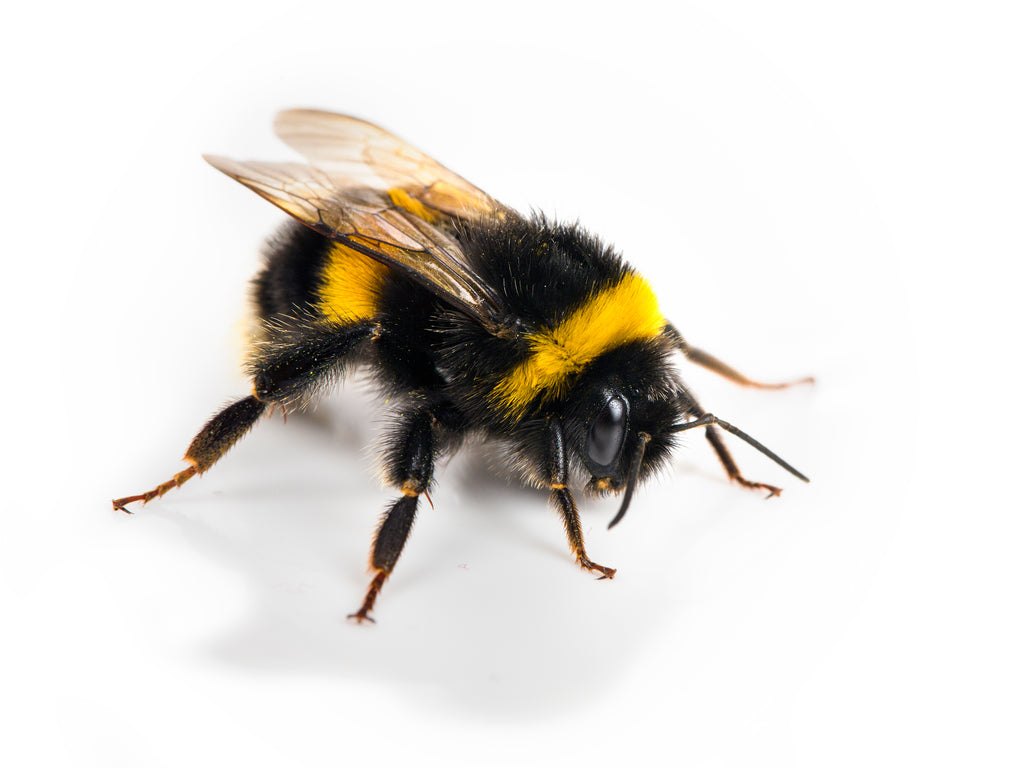
Fury Bumble Bee with Black and Yellow Stripes
What Does a Carpenter Bee Look Like?
The carpenter bee is not as soft/fuzzy as the bumble as it has only a small portion of hair on its middle abdomen. As for color, some carpenter bee species are all black while some have similar yellow markings to the bumble bee but only on their head. The lower abdomen has little to no hair and appears black and shiny which is why they are occasionally referred to as black bees. A female carpenter bee has mandibles on the front of her head for the purpose of drilling holes into wood. These black bees can be hard to identify, but focusing on these small physical differences & the differences in actions should help identify your black fuzzy bees.
Want to learn more about the black carpenter bee, check out our Anatomy of a Carpenter Bee blog post.
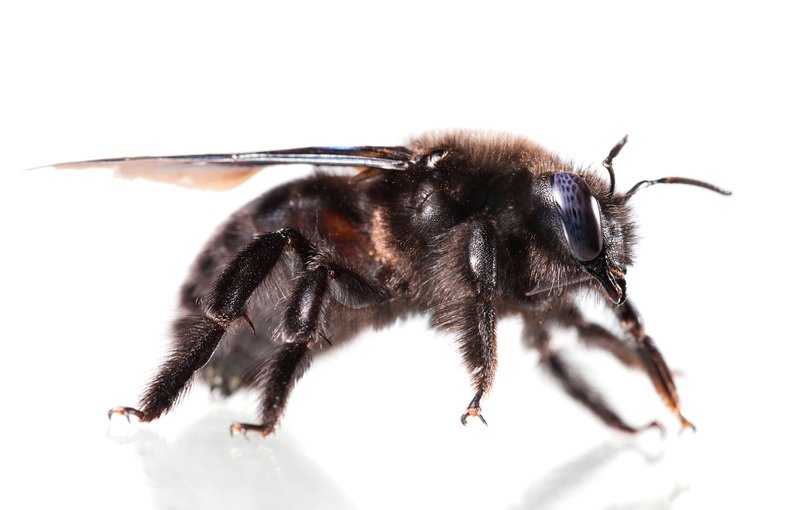
Black and shiny Carpenter Bee
By no means do we want to make you more confused, but let’s briefly review the appearance of a honey bee to prevent any confusion. First off, honey bees are more commonly mistaken for bumble bees due to their color similarities. However, honey bees tend to have more stripes and a few gray/white stripes on the abdomen compared to a bumble bee. Additionally, honey bees have short tongues and therefore mainly pollinate open flowers.
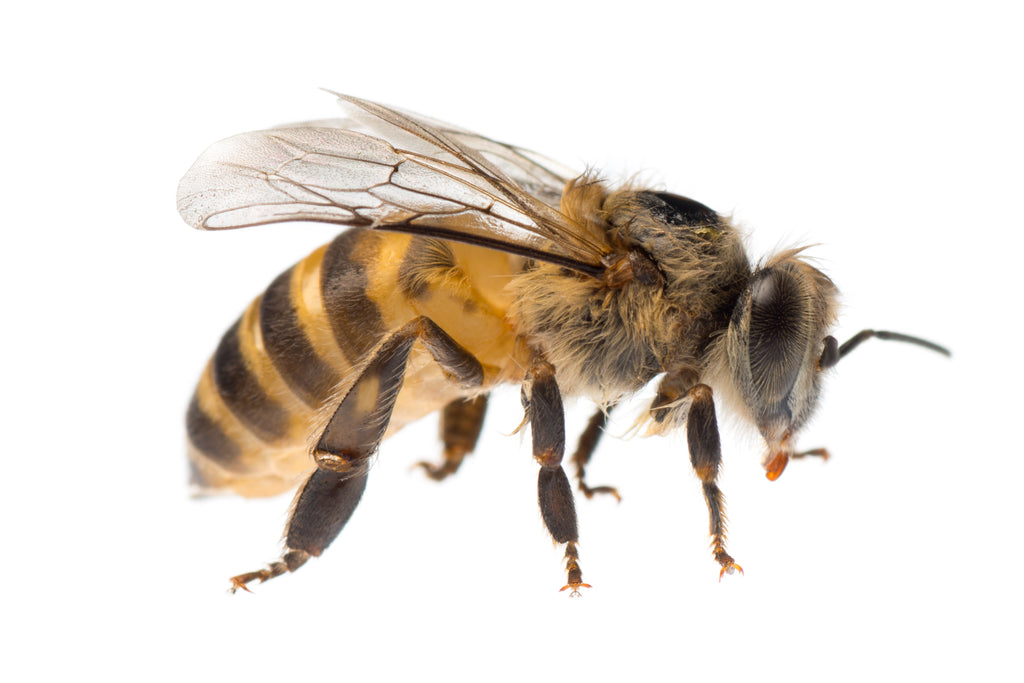
Pollinating Honey Bee
Behavior of Large Black Bees
Both of these bees have extremely different behavior.
The bumble bee is a social bee and lives in an underground colony which can hold as few as 50 bumble bees; the colony is not large like a honey bee colony. Living underground allows them to avoid overheating and direct sunlight; nests in temperate regions will only last one season. The queen bee feeds constantly to gain fat, which allows her to go into a resting state and hibernate all winter. Once spring rolls around, she will emerge and create a new colony. The female bumble bee, known as a working bee, spends its days gathering nectar and working on the colony. The male bumble bee, known as a drone, also works in the colony.
The carpenter bee is a solitary bee and does not live in a colony. The female carpenter bee will find a male carpenter bee to mate and nest with. The female spends her day building the nest for the family. She has mandibles on the front of her head that vibrate quickly against the wood grains, allowing her to build impressive nests in a short amount of time. The male carpenter bees’ days are spent protecting the female and the nest. Once the nest is built, the female will lay the eggs, each in a separate chamber and pack them full of nectar. When the task is done, the female and male will die in the nest. The next spring the young carpenter bees will emerge and eat the nectar left by the female.
Do Black Bees Sting?
Carpenter bees are very unlikely to ever sting you. These large black bees are very territorial so they will try to defend their nesting location, but this defense mechanism is more show than tell. Based on their mating habits mentioned above, the male carpenter bee is the defender of the nest, however male black bees will not sting as they do not have a stinger. They will approach you and buzz in your face, but there is no serious threat. Once past this first line of defense, you now can be in a position where it could end with you getting stung. Female carpenter bees can sting but are reluctant to do so as they will only do so if directly provoked while protecting their nests.
Female carpenter bees, unlike honey bees, are black bees that have smooth stingers and can sting more than once. Other fuzzy black bees, primarily honey bees, have barbed stingers which causes the stinger to get stuck in whatever material they decide to attack, which leads to fatality. These stings from either of the black fuzzy bees containing a venom (melittin) is what causes the irritation, swelling, & discomfort even after the stinger is removed. To learn more about these black carpenter bees, head over to our Male Vs Female Carpenter Bees & Do Carpenter Bees Sting blog post for more in-depth information on both topics!
If you are still confused as to which type of fuzzy black bee is buzzing around you, try to see if you can follow it to its home. A black carpenter bee will most likely nest within the wood of your home while a bumble bee will go underground. If the suspicious bee does, in fact, go into a wood portion of your home, our Carpenter Bee Turbo Trap will help you safely and easily remove the carpenter bees and prevent damage to the wood. Go to our Learn More tab to read about our trap, or watch videos to see what Best Bee Brothers can do for you.
If you want to draw the carpenter bees away from your home and into a safe habitat, check out our Bee Lodges, they provide an easy alternative for carpenter bees to nest freely without damage to your home.
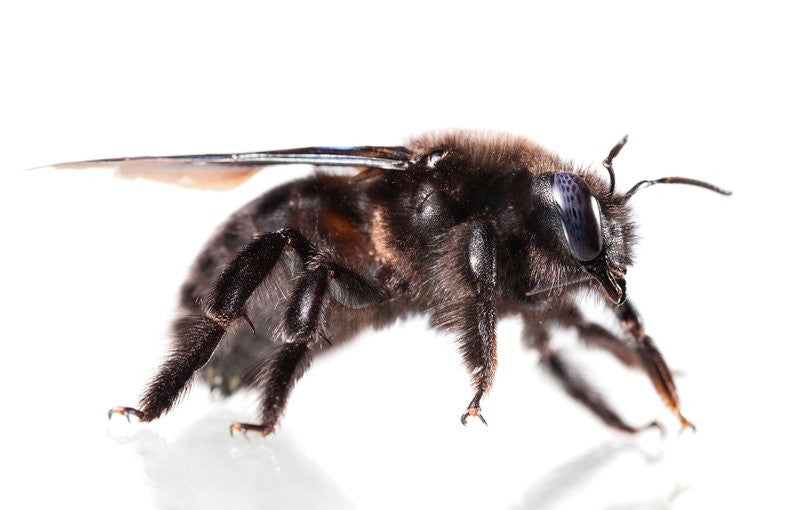

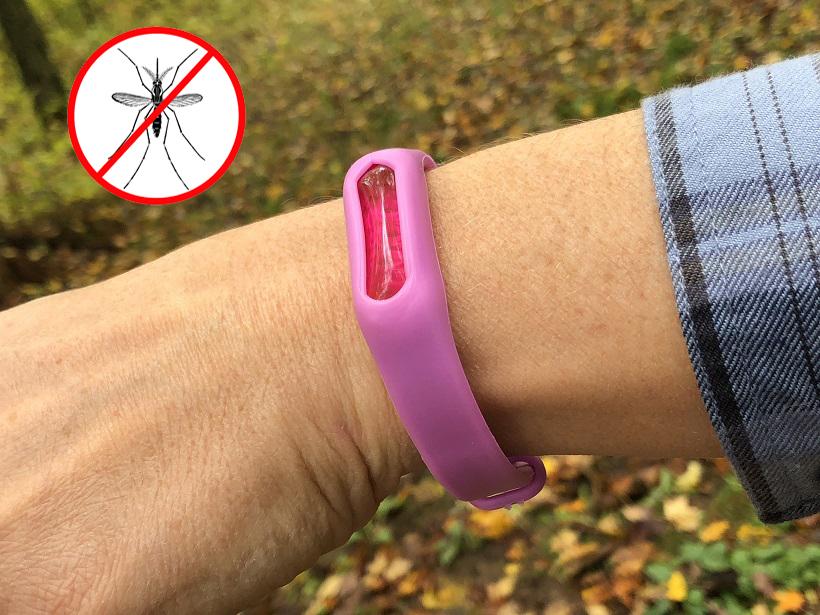






59 comments
Deborah Dunkum
I have two bees I cannot quite distinguish clearly. Both love my firecracker flowers.
I think one black one is certainly a carpenter bee. If they’re living in my arbor shall I have seen sawdust debris?
JH
Help Please!!! Just a few hours ago while taking my blind and deaf dog out in my back yard I noticed about 5 big fat, black, fast flying bees in the neighbors tree near by. I tried to get a better look at them with binoculars, from inside my glass patio door, but they fly too fast. I’m deathly allergic and can’t use an EpiPen since I’ve had 2 strokes. Now about 30 mins later, there must be 30 to 40 of them flying around, that tree branch into my property too, bumping into my patio door and FREAKING ME OUT!!! I let the neighbor know, since it’s her tree they are in. I’ve NEVER seen these bees in this tree in 16 years till today July 29th. We had a violent rain storm last night after weeks of no rain and today is about 98 degrees. Could that have caused them to come to her tree. Are they carpenter bees? The tree is huge, and they seem to be focused and circling out from one big, very high branch. We are in Kansas. Everything I’ve read about carpenter bees, says they are solitary, but from the size and shape they do seem to look like carpenter bees but they are flying everywhere now in my yard too. I have to be able to go in my back yard to take my blind and deaf dog out, feed 2 TNR feral cats and fill my birdfeeders but I don’t wanna die, as my Dr, stopped prescribing my yearly EpiPen 10 years ago after my 1st stroke and said EpiPen would cause me to have a massive heart attack or stroke. So my property has instantly turned into a war zone over night. Anyone have any idea what the hell is going on?? What are these monsters?? How did so many appear over night?? What do they want?? AHHHHHHHHHH :O
Customer Support
@ Kathryn – Carpenter bees can have yellow and white markings, they are not only black. The biggest identifier is if their back side is smooth and shiny, no hair. If they are all hairy, then it is definitely a bumble bee. It’s not uncommon to see many in one area, they just won’t all live together in the same nest.
Kathryn
I have purple sage growing in my front yard and it is FULL of large black bees, which I realize now are almost certainly carpenter bees. HOWEVER, I am wondering how, since they are solitary, there could be up to two dozen at once. Is it possible they are bumbles? Also, I had recently researched carpenter bees after spotting one who was not completely black, and was HOVERING. I read that male carpenter bees hover, so I’m confused. Lastly, I spotted a black bee with some yellow on its head (only) who attacked one of the big black bees. I rather thought this last bee might be a Mountain Carpenter Bee, but the attack left me wondering… Thanks.
Customer Support
@John Burger – Yes, our traps do kill the bees. Technically, carpenter bees are pollinators but not very good ones. They are inferior pollinators compared to honey bees and mason bees since carpenter bees tend to break off the pollen source of the flower and never pollinate another.
Leave a comment
All comments are moderated before being published.
This site is protected by hCaptcha and the hCaptcha Privacy Policy and Terms of Service apply.